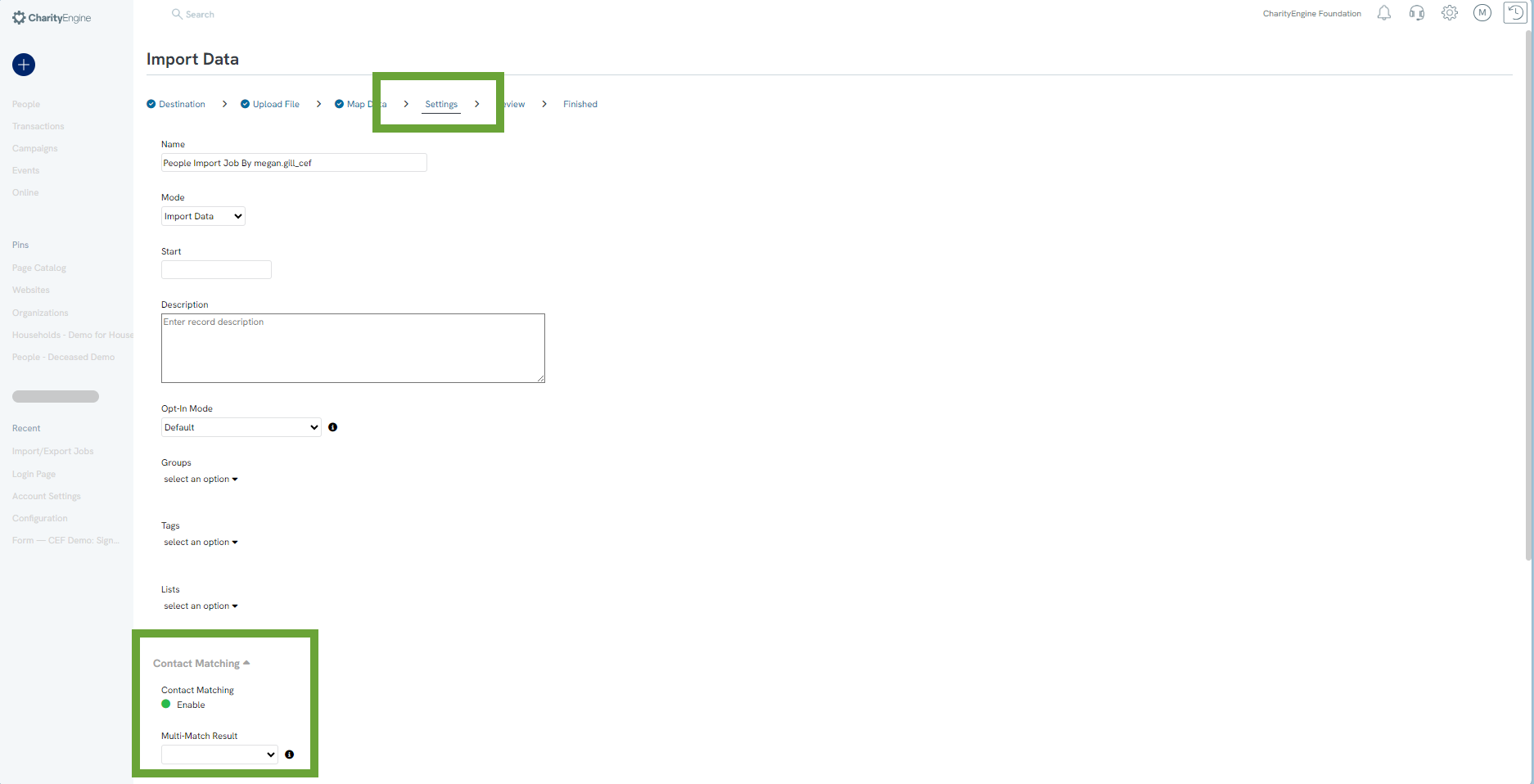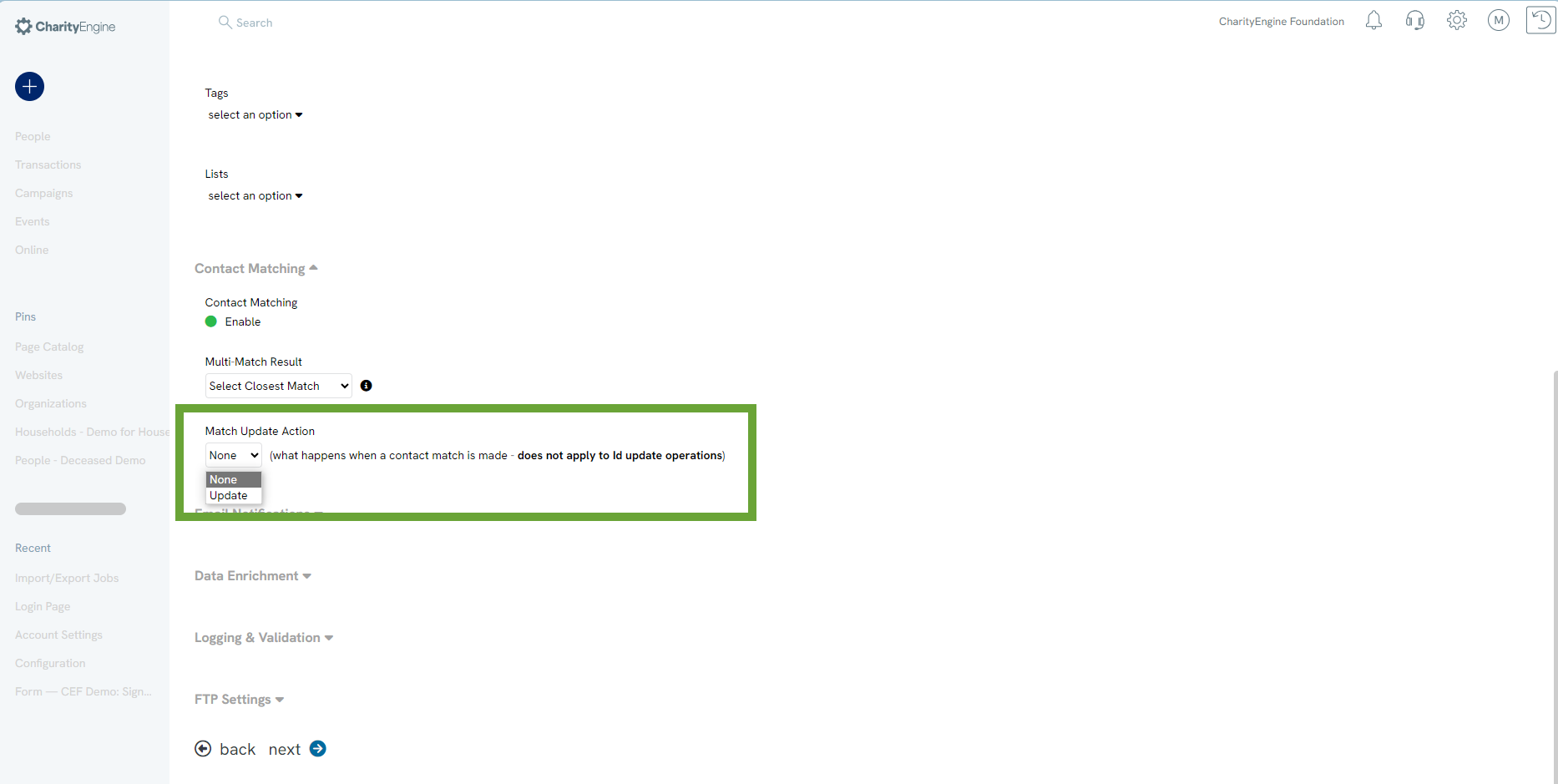Introduction
Whether you are adding contacts in bulk into your new account or adding additional contacts to an existing account, we know that having good data is essential for reporting and fundraising. CharityEngine's importing feature will assist in managing or identifying duplicate contact records.

Table of Contents
Prerequisites
- If you are completing your initial contact importing, CharityEngine recommends disabling matching as there is no data to match within the database. This will also allow the import to run much faster.
- If you are completing contact importing into your existing database with existing records, enable matching to leverage CharityEngine's logic to avoid importing duplicate records.
- Once Contact Matching is enabled, two
drop downs will appear, Multi-Match Action and Match Update Action.
Instructions - How "Contact Matching" Works
"Contact Matching" Feature - 15 criteria in which the system will match
-
- Name And Email And Phone And Address
- Name And Email And Address
- Name And Phone And Address
- Name And Email And Phone
- Name And Email
- Name And Address
- Name And Phone
- Email And Phone And Address
- Email And Address
- Phone And Address
- Email And Phone
- Email Address
- Address - If it is not an office*
- Phone Number
- Name
Example: You already have two existing contacts in CharityEngine and are entering a third. If you are using the Select Closest Match option, the
Contact Matching is located within the Data Jobs wizard within the Settings stop:

Contact matching will search the database for any contacts that share similar information
Instructions - How "Multi-Match Action" Works
Multi-Matching Action
Multi-Match Action is the action that will take place when multiple matches are found in CharityEngine but no matches are considered an exact match.
The Multi-Match Action
- Select Closest Match: This option will import the new data point(s) to the contact that matches closest to the information already input. The system will choose the closest match based on the 15 criteria listed above. These criteria are ranked, which means if there are multiple contacts with similar information, the system will choose the highest ranked match criteria.
- Create Duplicate Record: This option will create a new record for the contact and creation of a duplicate contact record.
- For example, if three people are in the same household, containing the same mailing address, but emails and other contact information differs. You would not want to import the new contact information to a contact that already exists but create a new or duplicate contact. After the duplicate record has been imported, the duplicate records can be updated by navigating to the De-Dupe Page.
- Fail as Bad Record: This option will result in no action to the database and will result in the creation of a Bad Record txt file.
- As a best practice, CharityEngine suggests using this option first so you can easily identify the total number of contacts that may be identified as a duplicate record.
- From the Bad Record txt file, you can then determine your best approach for managing and attempt a second import of these records.
Multi-Match Action is located within the Data Jobs wizard within Configure Additional Job Settings:

Instructions - How "Match Update Action" Works
"Match Update Action" Feature - Determine the right setting
The second important
- None: This option will result in no change to the existing contact and contact data. This action will however add new data if the existing data element is currently null.
- Update: This option will result in an update to the matched contact’s data with the data in the import file. New data from the import file will overwrite any information on the contact record.
Match Update Action is located within the Data Jobs wizard within Configure Additional Job Settings:

FAQs & Additional Reading
A. Learn more about people contact importing and best practices here.
A. When importing a contact that has similar contact information as another contact, but is a different person, or you are unsure if you already have a contact in your database, this is the best option to choose. For example, if three people are in the same household, they will have the same address and possibly the same phone number, but their emails and other contact information is different. You would not want to import the new contact information to a contact that already exists but create a new or duplicate contact. After the duplicate record has been imported, the duplicate records can be updated by navigating to the Automation & Workflow App > Contacts > De-Dupe People feature.


